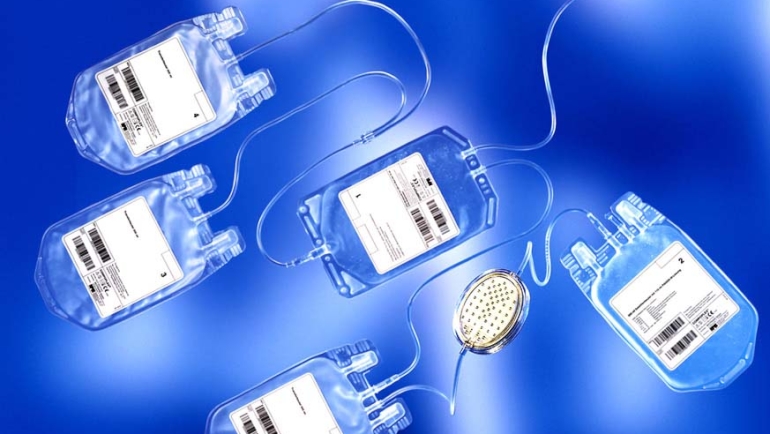Transfusion Medicine and Cell Therapies

For blood donation and component processing, Fresenius Kabi offers medical devices. These include cell separators (apheresis systems), autotransfusion devices, blood bag and filter systems as well as related blood processing equipment. Component processing consists of the separation and collection of certain blood cells.
Blood Cell Separator
The Fresenius cell separator has three areas of application:
- Donate blood cells: obtaining cells from the blood of a donor for transfusion, for example for treating coagulation dysfunctions or leukemia patients
- Remove cancer cells: removing diseased cells or blood plasma from the blood of a patient with leukemia or an autoimmune disease, i. e., in patients with disorders where the body produces defense substances against its own cells
- Collect a patient’s cells: collecting cells from a patient's own blood for re-infusion, for example prior to operation.
A cell separator is primarily used to collect blood platelets or thrombocytes. While red blood cells mainly transport oxygen and other blood cells ward off pathogens, thrombocytes play an important role in blood clotting. Patients with too few thrombocytes suffer from an inability of the blood to coagulate properly. Injuries can lead to potentially dangerous bleeding. One example of the cause of thrombocyte deficiency is cancer therapy. Doctors infuse patients with healthy donor thrombocytes following treatment.
Thrombocytes are obtained most effectively with a blood cell separator. The machine, which works like a centrifuge, gently separates thrombocytes from the other blood components. Components that are not needed are immediately returned to the donor. Because only the thrombocytes are taken, which regenerate much quicker than red blood cells, a donor may donate much more frequently than in regular whole-blood donations. The cell separator also allows a much larger number of thrombocytes to be collected per donation than in whole blood. All patients who require a large number of thrombocytes can benefit double from the procedure – regular transfusions include thrombocytes from several sources but a blood cell separator can reduce the number of donors needed per transfusion. This allows a doctor to select thrombocytes from the most appropriate donors. This is important because the efficacy of the thrombocytes improves when the blood groups of donors and recipients match.
A cell separator can separate thrombocytes from other blood cells; it can also support the treatment of leukemia patients by removing diseased cells directly from the blood. Since leukemic cancer cells quickly reproduce, this procedure cannot heal a patient. But it relieves the strain on the kidneys by considerably lowering the number of destroyed cancer cells that must be removed from the blood following treatment.
Although rarely used, another application of the blood cell separator is quickly gaining in importance. Doctors can use the device to remove stem cells from the blood of a cancer patient. Through pre-treatment bone marrow stem cells start to reproduce and partially move into the blood stream. These stem cells can be collected almost like platelets. This way surgery to obtain stem cells directly from bone marrow can be avoided.
The treatment subsequently used to combat cancer cells damage the stem cells from which all other blood cells are made. If the patient receives healthy stem cells after chemotherapy, healthy blood cells can develop quicker, for example the platelets that are important for hemostasis and coagulation.
Blood bag systems
Blood bag systems are the foundation for worldwide blood supply by "classical" blood donation. More than 90 percent of all blood donations are processed in these systems that consist of up to six different bags with variable functions.
A combination of bags with venous cannulae and integrated needle protection, pre-donation sampling pouches and different filtration devices form the basis for highly professional whole blood collection systems. They allow producing different blood component preparations according to national and international standards. Blood donation and processing with these systems is supplemented by other devices such as automated scales and blood separators, sterile docking systems and sealers to name a few.
Contact
Fresenius Kabi AG
Else-Kröner-Str. 1
61352 Bad Homburg
Germany
T: +49 6172 686-0
communication@fresenius-kabi.com

